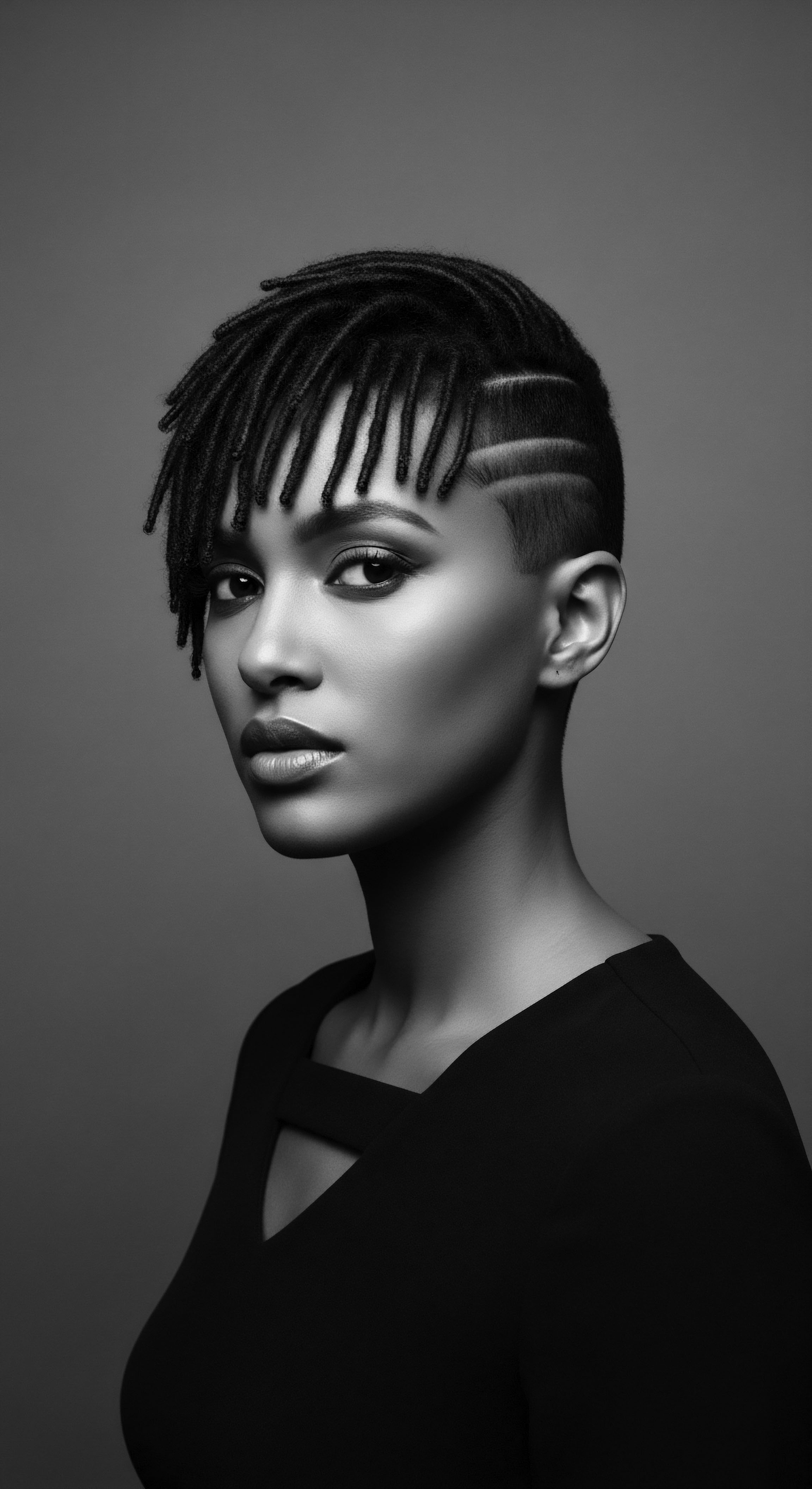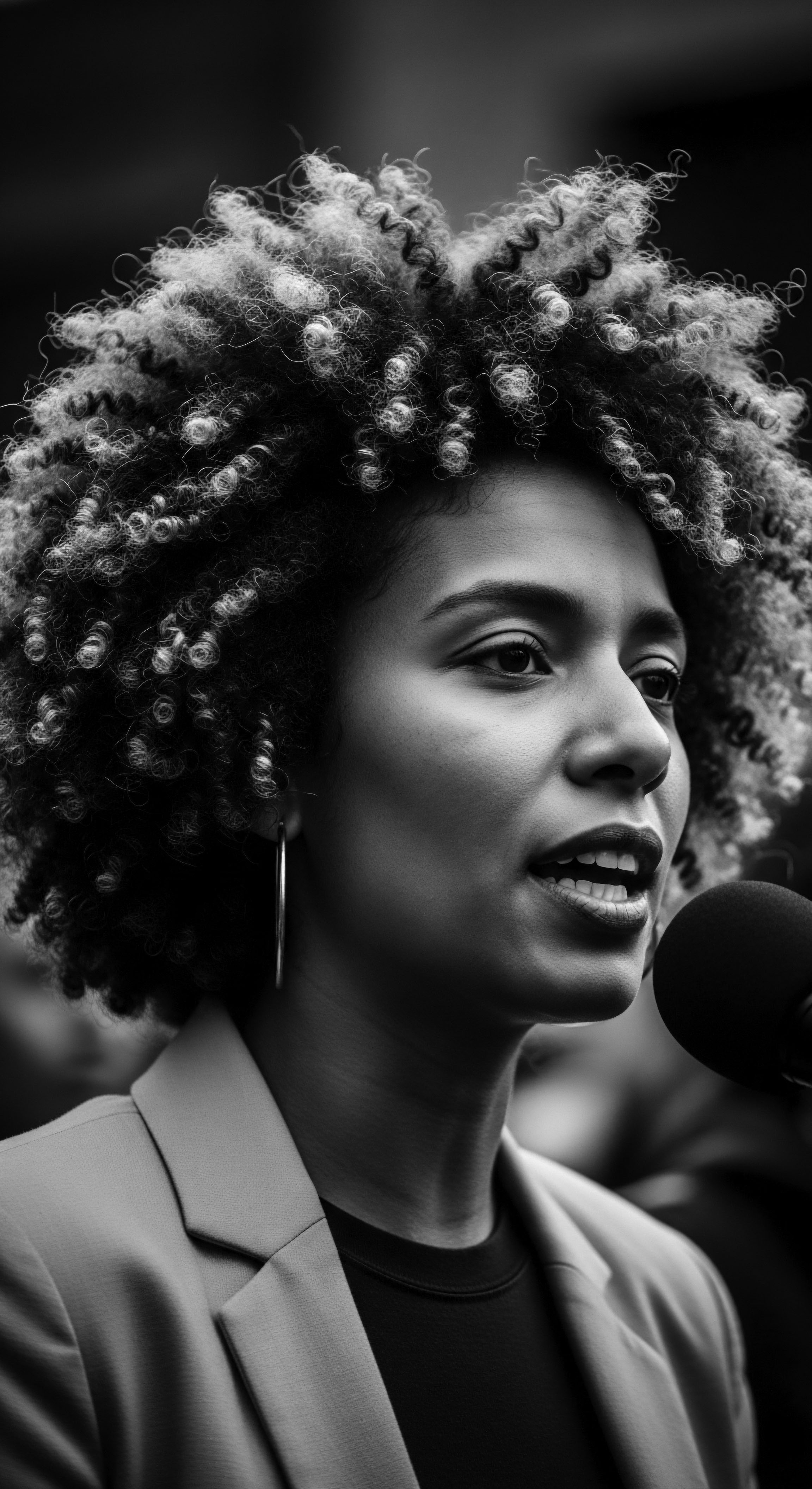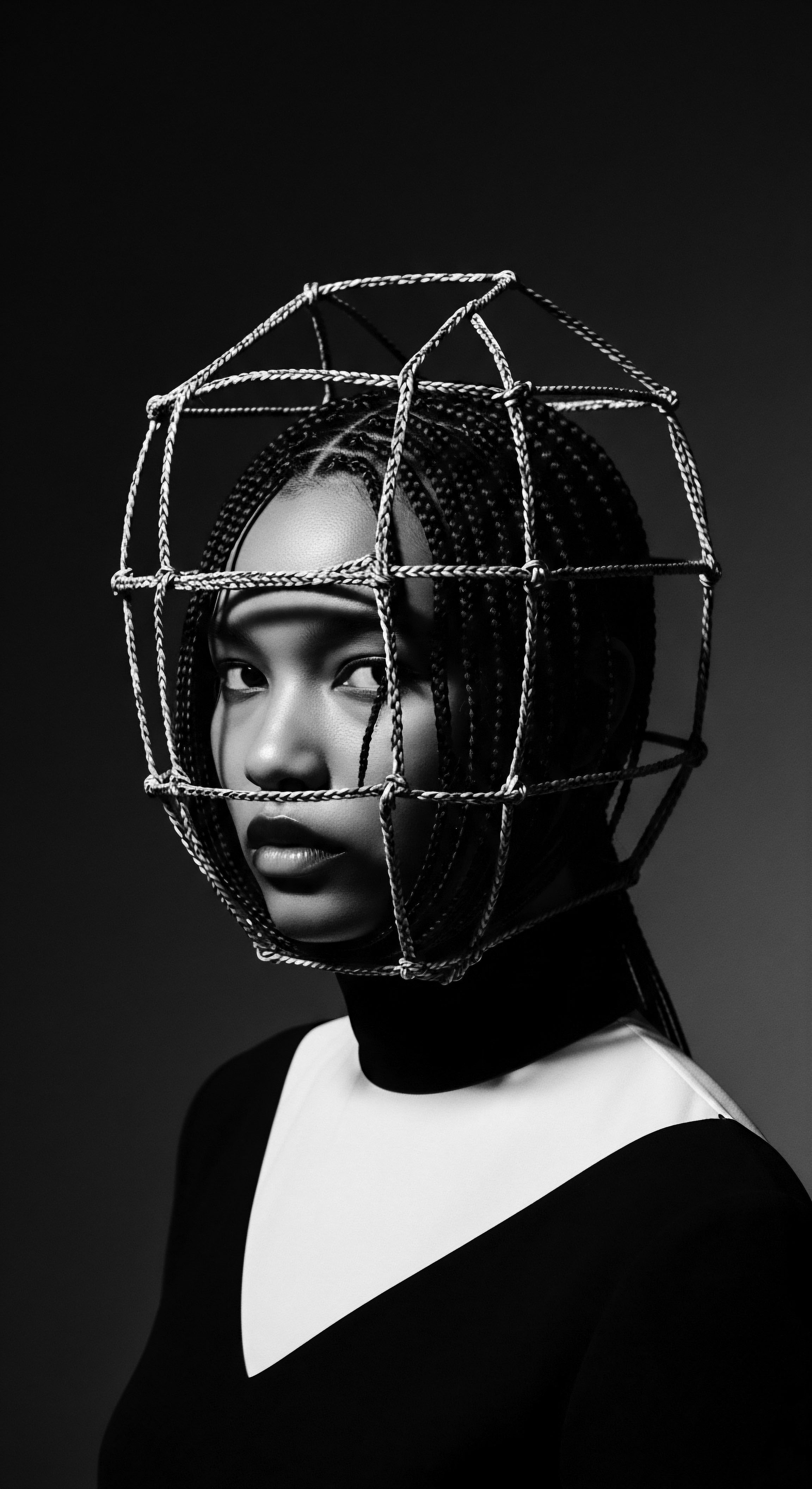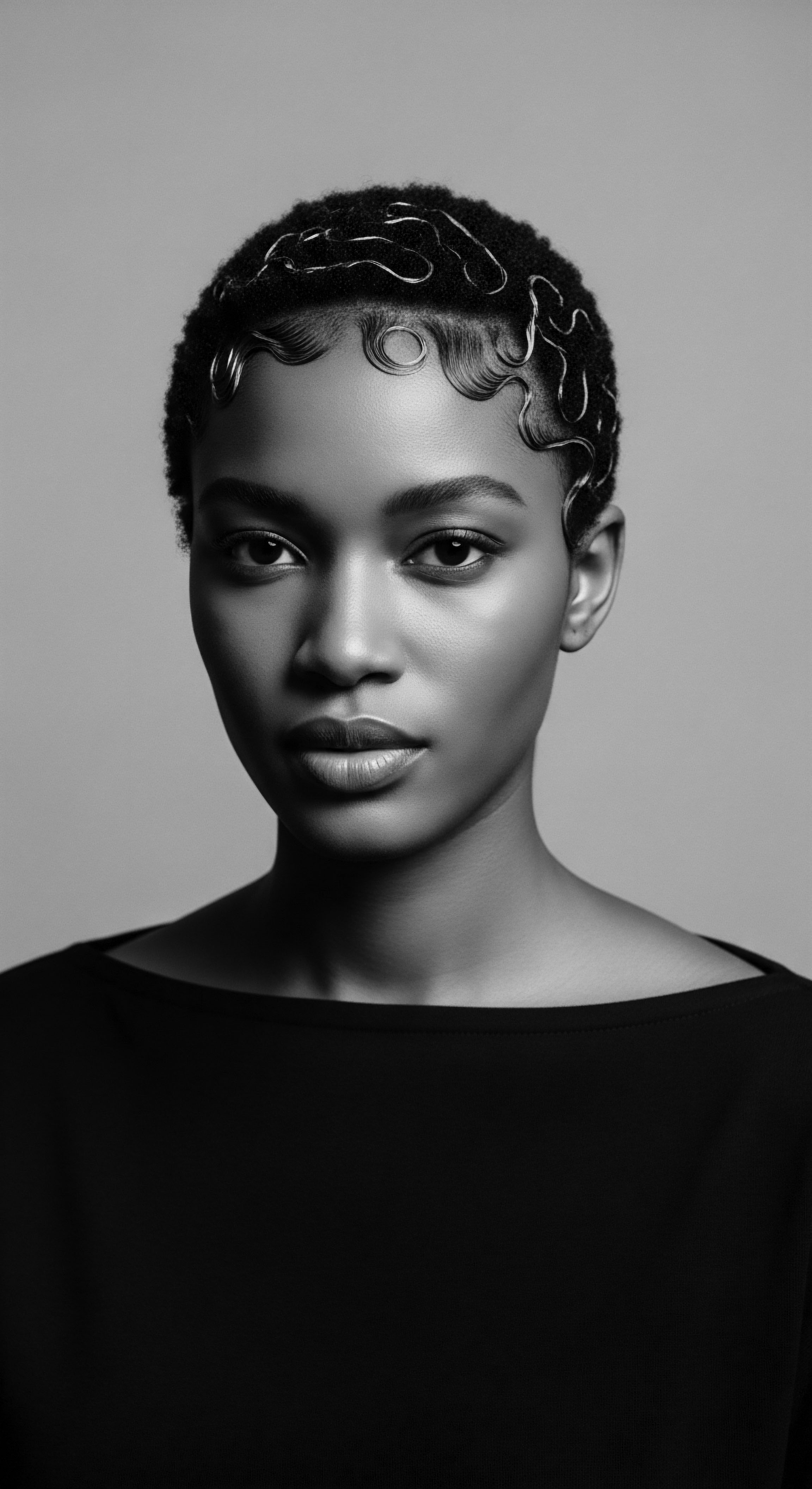
Roots
Do you ever feel the subtle stirrings within your strands, a whisper carried from distant shores? For those graced with coils and kinks, with the exquisite complexity of textured hair, this sensation often speaks to a heritage both visible and deeply felt. The headwrap, in its countless forms, stands as a tangible echo from ancestral lands, a garment of utility and profound meaning intertwined with the very biology of hair and the lived experiences of generations. It is a story told not in words alone, but in fabric, in intention, and in the timeless gesture of covering.
The origins of head coverings stretch back across millennia, serving practical needs long before they became cultural statements. Early communities, particularly in diverse African regions, recognized the wisdom of safeguarding their hair from the elements. Harsh sun, arid winds, and dust could compromise delicate hair structures, leading to dryness and breakage.
The hair shaft, with its unique patterns of cuticle scales in textured hair, requires a thoughtful shield against environmental stressors. A simple cloth, wrapped with care, provided this fundamental protection.

Ancestral Biology and Hair Protection
To truly comprehend the headwrap’s foundational role, one must consider the inherent characteristics of textured hair. Unlike straighter hair types, coiled and kinky strands naturally possess fewer cuticle layers that lie flat. This architectural difference, a testament to hair’s incredible adaptability, means these strands can be more susceptible to moisture loss. Air currents and direct sunlight, over time, extract precious hydration.
Here, the headwrap entered the scene as a remarkably effective barrier. By enclosing the hair, it created a microclimate, preserving natural oils and applied moisture, allowing the strands to retain their pliable nature. It was a practical, intuitive response to environmental conditions, born of observation and accumulated wisdom.

Early Materials and Their Qualities
The choice of materials in early headwraps reflected a deep understanding of available resources and their properties. While modern discussions often center on silk and satin for their smooth glide, earlier iterations relied on natural fibers.
- Cotton ❉ Readily available in many regions, cotton provided breathability and a degree of softness, making it suitable for daily wear and protection against dust or sweat.
- Hand-Woven Textiles ❉ Indigenous communities crafted textiles from local plant fibers, often with region-specific patterns, providing varying textures and levels of density to suit different climates and purposes.
- Animal Hides/Skins ❉ In some colder or harsher environments, animal skins might have offered additional warmth and durability, though less common for direct hair contact.
These materials, while perhaps not possessing the glide of contemporary satin, still offered a significant physical shield, minimizing exposure to external factors that could compromise hair health. The careful selection and preparation of these fabrics marked the initial steps in a long-standing tradition of hair care through covering.
The headwrap’s journey began as an intuitive shield, safeguarding textured hair’s delicate balance against the whims of nature.

Ritual
From its primordial role as a simple shield, the headwrap ascended to a realm of profound meaning, weaving itself into the very fabric of daily ritual and communal identity. It transformed from a mere accessory into a silent language, a visual declaration of status, belief, and belonging. This evolution, particularly within African cultures and across the diaspora, reveals the profound connection between personal adornment and collective heritage.

Daily Practices and Cultural Communication
Across countless African societies, the headwrap transcended mere functionality. It became an integral part of sartorial expression, signaling a woman’s age, marital status, wealth, or spiritual devotion. The manner of tying, the patterns on the cloth, the colors chosen – all conveyed intricate details, understood implicitly within specific communities.
A Ghanaian woman’s Duku, a Yoruba woman’s towering Gele, or a South African’s Doek each carried distinct narratives, often indicating their tribal affiliation, family lineage, or even whether they were in mourning or celebration. This non-verbal communication was a subtle yet powerful aspect of daily life, connecting individuals to their heritage in a deeply personal and public way.
Beyond grand ceremonies, the headwrap became a staple of everyday care for textured hair. It served as a practical solution for managing hair, especially during physical labor, keeping strands protected from dirt and sweat. This practical application dovetailed with a deeper understanding of hair as something sacred, something requiring constant care and respect. It allowed for intricate hairstyles to be preserved, extending the life of braids or twists, reducing the need for constant manipulation which can lead to breakage.

How Did Headwrap Styles Convey Identity and Status?
The artistry of head wrapping was, and remains, a sophisticated craft. A particular fold, a certain height, the direction of a knot – these were not arbitrary choices. They were deliberate acts of communication, conveying a spectrum of information about the wearer’s place within their community. For instance, in some West African traditions, the height and elaboration of a Gele could indicate social standing or wealth, becoming a visual crown.
| Cultural Context Yoruba (Nigeria) |
| Headwrap Name/Style Gele |
| Symbolic Meaning Social status, celebration, elegance, marital status, wealth. |
| Cultural Context Ghanaian |
| Headwrap Name/Style Duku |
| Symbolic Meaning Everyday wear, protection during chores, cultural identity. |
| Cultural Context Southern Africa |
| Headwrap Name/Style Doek (Afrikaans) / Iduku (isiZulu) |
| Symbolic Meaning Cultural pride, womanhood, respect for elders, dignity. |
| Cultural Context Ethiopian Orthodox Church |
| Headwrap Name/Style White lace coverings |
| Symbolic Meaning Faith, religious observance. |
| Cultural Context These examples reflect how headwraps became a canvas for shared cultural narratives and individual expression across diverse communities. |

The Sacredness of Hair in Ancestral Thought
For many ancestral African belief systems, hair was more than mere adornment; it was regarded as a spiritual antenna, a conduit to the divine, holding individual and collective power. Hair, especially at the crown, was seen as the closest point to the heavens, a sacred site. Covering the hair with a headwrap, therefore, carried spiritual implications – a gesture of respect, humility, or even protection from negative energies.
This spiritual reverence meant that hair care, including the act of covering, became a ritualistic practice, honoring the body’s connection to the spiritual realm and the wisdom of ancestors. The very act of wrapping could be a meditative process, a moment of grounding and self-care.
The ritualistic dimension extended to specific life events. In many African cultures, the first wearing of a headwrap might symbolize a girl’s transition to adulthood, a coming-of-age ceremony where elder women passed down not just the techniques of tying, but also the wisdom and stories connected to the cloth. These moments cemented the headwrap’s role as a living archive of heritage , physically embodying continuity from one generation to the next.
Headwraps transformed into symbolic expressions, communicating societal roles and spiritual connections through patterns, colors, and the very act of wrapping.

Relay
The story of headwraps, particularly for textured hair heritage, is not confined to the ancestral lands; it journeyed across vast oceans, adapting and transforming within the crucible of the diaspora. In this transmission, the headwrap shifted from a sign of cultural belonging to a potent symbol of defiance, resilience, and reclamation, carrying the whispers of ancestral wisdom through generations of trials and triumphs. It became a living testament to the enduring spirit of communities confronting profound shifts in their circumstances.

Headwraps As Resistance and Reclamation in the Diaspora
The transatlantic slave trade forcefully dislocated millions, but it could not extinguish their cultural memory. Hair practices, including head coverings, traveled with them, morphing in meaning under the shadow of oppression. In the Americas and Caribbean, what was once a sign of pride and identity was frequently stripped of its original context and imposed as a marker of servitude. Slave owners often mandated head coverings for enslaved Black women, aiming to diminish their beauty and assert control over their appearance.
This act intended to dehumanize, to render invisible the rich cultural identity often expressed through elaborate hairstyles. Yet, remarkably, enslaved women turned this imposition on its head.
Consider the Tignon Laws of 1786 in Spanish colonial Louisiana. These laws explicitly required free women of color, whose elaborate hairstyles and refined dress often rivaled or surpassed that of white women, to cover their hair with a simple kerchief or “tignon.” The intent was to visually enforce a racial hierarchy, demoting these women to a lower social stratum. However, these women, with breathtaking ingenuity, subverted the law.
They adorned their tignons with exquisite fabrics, ribbons, jewels, and feathers, transforming an instrument of oppression into a statement of defiant elegance and cultural pride. (Johnson, 1996) This transformation was not merely a fashion statement; it was an act of profound resistance , a quiet but powerful assertion of selfhood and unbroken heritage in the face of systemic dehumanization.
From enforced concealment to defiant adornment, headwraps became a powerful symbol of self-assertion against oppressive forces.

Connecting Modern Science to Ancestral Wisdom Through Headwraps?
The practical protective qualities of headwraps, understood intuitively by ancestors, find affirmation in modern hair science. Textured hair, with its unique helical structure, is particularly vulnerable to mechanical friction and moisture loss. Cotton pillowcases, for instance, can absorb moisture from hair and create friction, leading to frizz and breakage. This scientific understanding sheds light on the centuries-old practice of covering hair at night.
| Traditional Understanding Shield against sun, dust, and wind. |
| Modern Scientific Validation Reduces environmental damage, UV exposure, and physical weathering of the hair shaft. |
| Traditional Understanding Retains moisture and oils. |
| Modern Scientific Validation Creates a humid microclimate, preventing evaporation of natural sebum and applied products, crucial for low porosity hair. |
| Traditional Understanding Preserves hairstyles, reduces manipulation. |
| Modern Scientific Validation Minimizes daily styling, combing, and external friction, which are primary causes of breakage for fragile hair. |
| Traditional Understanding Softness for sensitive hair. |
| Modern Scientific Validation Silk and satin linings reduce friction against the hair cuticle, preventing frizz, tangles, and mechanical damage during sleep or wear. |
| Traditional Understanding Ancestral practices, like head wrapping, often contained inherent scientific validity, serving hair health long before modern laboratories confirmed their efficacy. |
The resurgence of headwraps in contemporary fashion and hair care circles, particularly within the natural hair movement, stands as a testament to their enduring relevance. This is a deliberate act of choosing tradition, reclaiming ancestral practices not just for aesthetic appeal but for their proven benefits to hair health. The move towards satin and silk-lined bonnets and wraps for nighttime protection directly correlates with the historical recognition of protective head coverings.
These materials, with their smooth surfaces, reduce friction, allowing curls and coils to glide without snagging, thus preserving moisture and preventing breakage during sleep. This contemporary embrace connects directly to the legacy of practicality and care passed down through lineages.

How Did Headwraps Adapt to Colonial Control and Reclaim Identity?
The forced wearing of head coverings during slavery, which aimed to homogenize and degrade, unwittingly preserved a framework for resistance. While cotton kerchiefs were often plain, African women found ways to infuse them with personal style, tying them in elaborate ways that reflected their inner world and external community. This subversion of purpose laid the groundwork for future generations to consciously adopt headwraps as symbols of cultural pride and political expression.
The Black Power Movement of the 1960s and 70s, for instance, saw headwraps re-emerge as a powerful statement of Afrocentric identity and rebellion against Eurocentric beauty standards. This period marked a deliberate, collective choice to visually assert a connection to African roots, transforming a historically imposed garment into a uniform of self-love and defiant beauty.

Reflection
The headwrap, a seemingly simple piece of fabric, holds a boundless narrative within the heritage of textured hair. It stands as a profound testament to resilience, an unbroken connection to ancestral wisdom, and a vibrant canvas for self-expression through generations. From its fundamental role in safeguarding fragile coils against the elements to its transformation into a defiant symbol of identity against oppression, the headwrap has always been more than an accessory. It is a living, breathing archive of stories, practices, and triumphs, echoing the very ‘Soul of a Strand’—the intrinsic spirit and strength residing within each curl and kink.
The enduring presence of headwraps in our daily lives and cultural celebrations today underscores a powerful continuity. It reminds us that our hair heritage is not static, a relic of the past, but a dynamic, ever-evolving source of strength and knowledge. When we wrap our hair, whether for protection, style, or spiritual connection, we participate in a timeless ritual, honoring the ingenuity and grace of those who came before us.
This shared practice bridges continents and centuries, affirming the beauty of our lineage and the unbreakable spirit of textured hair. The headwrap remains a quiet, yet resounding, declaration of who we are, where we come from, and the vibrant legacy we carry forward.

References
- Johnson, Helen. (1996). The Tignon ❉ A Louisiana Creole Woman’s Resistance. Journal of the Afro-American Historical and Genealogical Society, 17(1), 3-10.
- Griebel, Helen Bradley. (1994). The African American Woman’s Headwrap ❉ Unwinding the Symbols. History and Archaeology, 28, 7-18.
- Stillman, Amy. (2018). Black Tignons and the Performance of Freedom in Nineteenth-Century Louisiana. Dress, 44(2), 125-146.
- Byrd, Ayana, & Tharps, Lori L. (2014). Hair Story ❉ Untangling the Roots of Black Hair in America. St. Martin’s Griffin.
- Mercer, Kobena. (1994). Welcome to the Jungle ❉ New Positions in Black Cultural Studies. Routledge.
- White, Deborah Gray. (1914). Ar’n’t I A Woman? ❉ Female Slaves in the Plantation South. W. W. Norton & Company.
